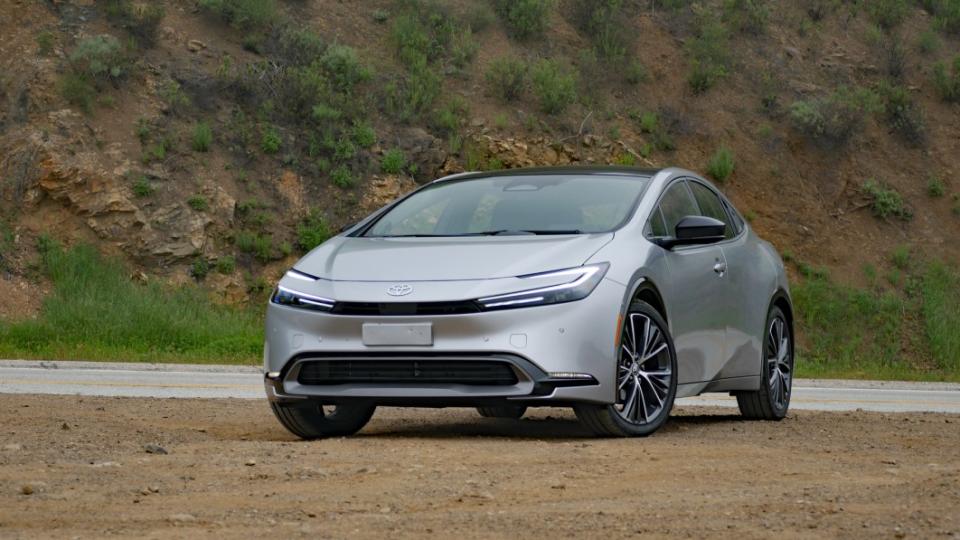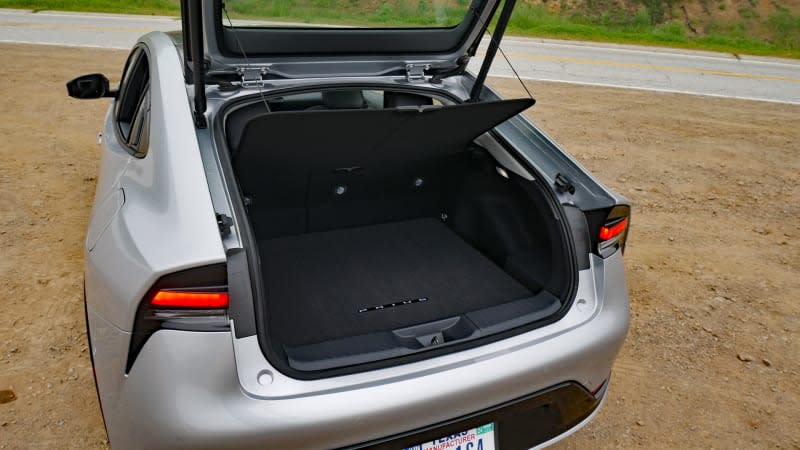2023 Toyota Prius Review: It's not just about sky-high MPG anymore

Pros: Excellent fuel economy; cool looks; optional all-wheel drive; quick for a hybrid; good interior storage
Cons: Small cargo area; gauges may be hard to see; tech can frustrate
Why yes, the car you see up there is a 2023 Toyota Prius. Looks good, doesn’t it? And not just “looks better than the old one,” cause that’s an extremely low bar, but legitimately good. Cool even. We don’t usually discuss the merits of car design since it’s so reliant on personal preference, but in this case, it’s such a major part of the new Prius story. Not only will you save a bunch on gas, but you no longer have to drive something that looks dorky (or worse) to do it.
Once again, the Prius is available in regular and plug-in hybrid Prius Prime versions, with the regular offering all-wheel drive. That’s rare for an eco-oriented car at this price range, even those marketed as crossovers like the Kia Niro and Chevy Bolt EUV. Fuel economy for the regular Prius is basically the same as before (between 49 and 57 mpg combined depending on trim level), but a serious increase in power has dramatically improved Prius acceleration. The impact is even greater in the Prime plug-in hybrid, which is not only massively quicker than the old one (0-60 mph in 6.6 seconds versus a slug-like 10.2), but genuinely quick, period. It has twice as much electric range, too, with either 44 or 39 miles depending on trim.
At the same time, the new Prius is far better to drive than before, with more responsive steering, a more composed suspension and quieter, smoother operation of its hybrid system. The interior is also more conventional in terms of control and display placement, and materials quality has improved. It’s not quite as spacious, especially in the cargo area, but in general, this is such a massively superior car from both an objective and subjective perspective that it deserves far more attention from any car buyer looking to save as much gas as possible without going fully electric.
Interior & Technology | Passenger & Cargo Space | Performance & Fuel Economy
What it's like to drive | Pricing & Trim Levels | Crash Ratings & Safety Features
What's new for 2023?
The Prius is all-new for 2023 with the exception of its underlying platform. Check out the video above to dig deeper.



What are the Prius interior and in-car technology like?
Those coming from a previous Prius generation are bound to find things have moved around a bit inside: The shifter is now on the center console and the gauges are directly in front of the driver. For those coming from any other car, you’ll find the new Prius refreshingly normal. That goes for both functionality and appearance, but in terms of the latter, it’s an attractive design that doesn’t lose itself to its tech elements. Materials quality is improved, with above-average materials for eco-oriented cars in this price range. The center console also offers thoughtful storage: big cupholders, a clever vertically oriented wireless phone charger, a large forward bin and a cavernous under-armrest bin.
We like that Toyota has maintained separate, physical controls for the climate system rather than mashing everything into the touchscreen as other brands increasingly do (including Lexus). The latest Toyota infotainment system is present, which works the same regardless of whether you get the standard 8-inch size or the 12.3-inch unit found in the uppermost trim levels. This system is certainly one of the better-looking ones, but it suffers from a few snafus that have us pulling our hair: no easy way to quickly exit Apple CarPlay/Android Auto, odd radio functionality and the navigation system erasing your preferred zoom and orientation settings every time you go to another touchscreen menu. Toyota ditching its old physical menu shortcut buttons is a big part of this.
Another controversial element is the gauge cluster. We like that it’s no longer in the middle of the car, but its placement above the pleasingly small steering wheel isn’t quite high enough to prevent the wheel rim from blocking the view for some drivers. The shorter you are, the greater the problem seems to be. Basically, Toyota solved one problem and created another.


How big is the Prius?
The Prius is basically the same size as its predecessor, and in terms of the wider automotive landscape, is basically a compact car like a Toyota Corolla and Honda Civic. It does pay a price for its racier looks, however. Cargo capacity is down by a not-insignificant 7 cubic feet for 2023, and in our cargo capacity testing, we found that it holds less luggage than a Kia Niro and Honda Civic Hatchback (which will be available as a hybrid next year). The lower, more raked roofline is the culprit here, which also reduces its versatility as a hatchback.
Rear seat headroom was already tight in the Prius and it basically stays the same despite the racier roofline. If you’re tall, your head is going to touch the roof. The slope of the door made it tricky to lift a kid into a child seat (and also increases the chances of adults clonking their heads). Legroom is just fine for a compact car, meaning four adults can fit quite comfortably. There’s no issue with space up front. The roof may be lower up there, but it was goofy-tall before, and the seat has been lowered. This not only creates sufficient headroom, but provides a more carlike driving position. A higher center console furthers the car’s overall racier feel as well as increasing storage.


What are the Prius fuel economy and performance specs?
The standard Prius hybrid powertrain now consists of a bigger, 2.0-liter inline-four and two electric motors, one of which contributes power to the front wheels. The all-wheel-drive Prius features a third motor powering the rear wheels. Total system output is 194 horsepower (up from a measly 121) or 196 hp with all-wheel drive. The car’s 0-to-60-mph time is 7.2 seconds (or 7 with AWD), which is quick for both a compact car and a hybrid.
Fuel economy is 57 mpg city, 56 mpg highway and 57 mpg combined for the base LE trim level. It drops to 52 mpg in city, highway and combined in the XLE and Limited trim levels. Opting for all-wheel drive drops those estimates down to 53/54/54 for the LE and 49/50/49 for the XLE and Limited. According to the EPA, the actual annual fuel cost difference between the most- and least-efficient regular Prius versions is only $150.

 Yahoo Autos
Yahoo Autos 
